
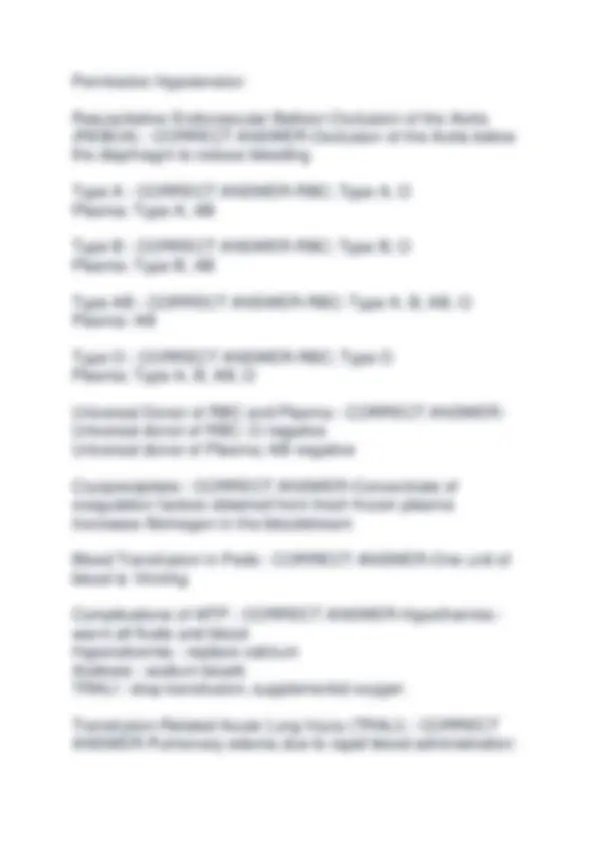
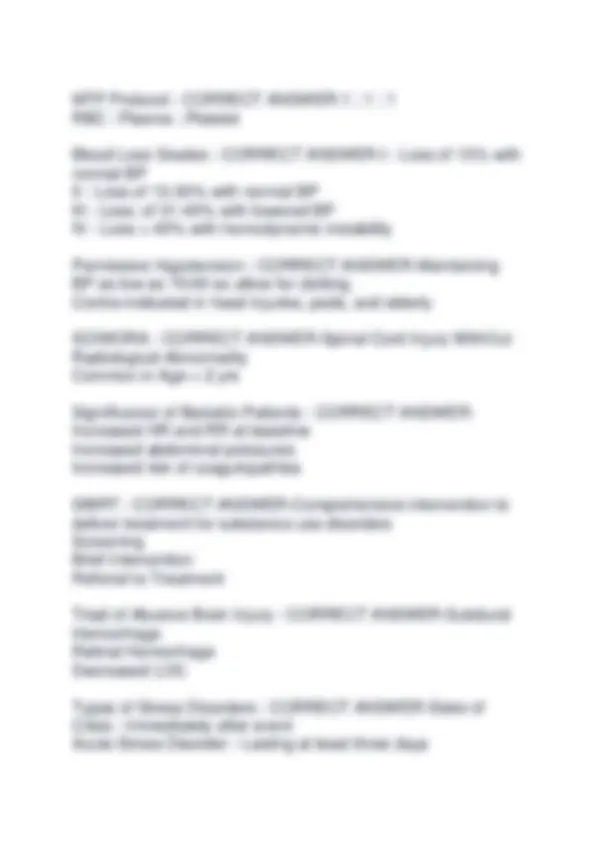
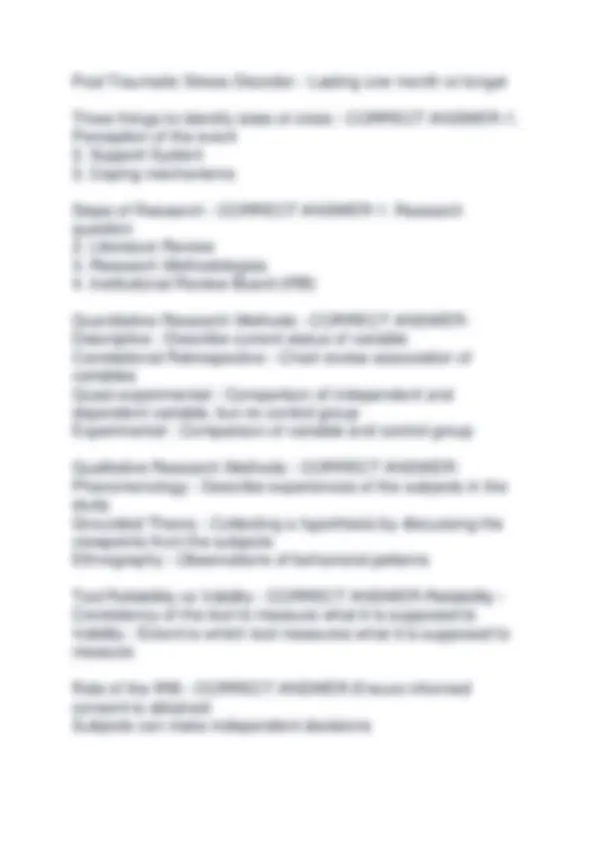
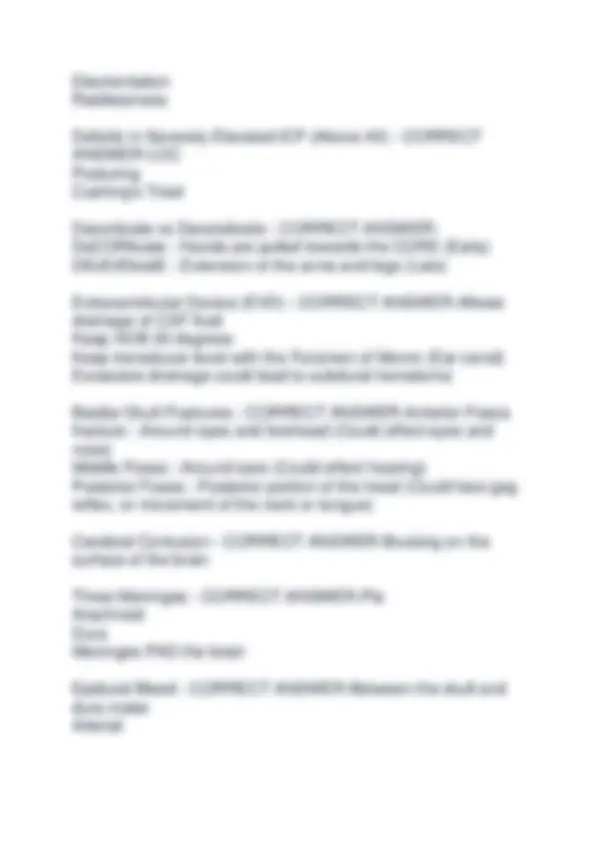

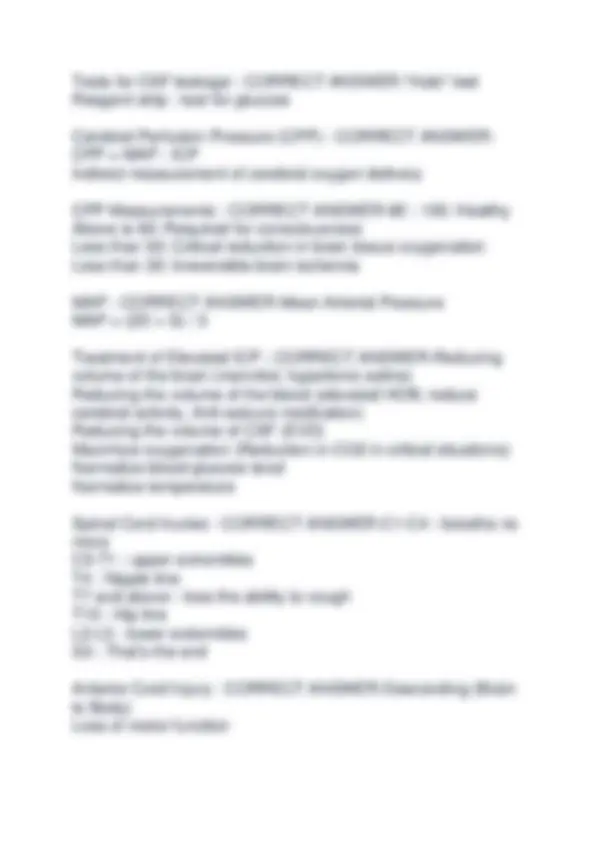
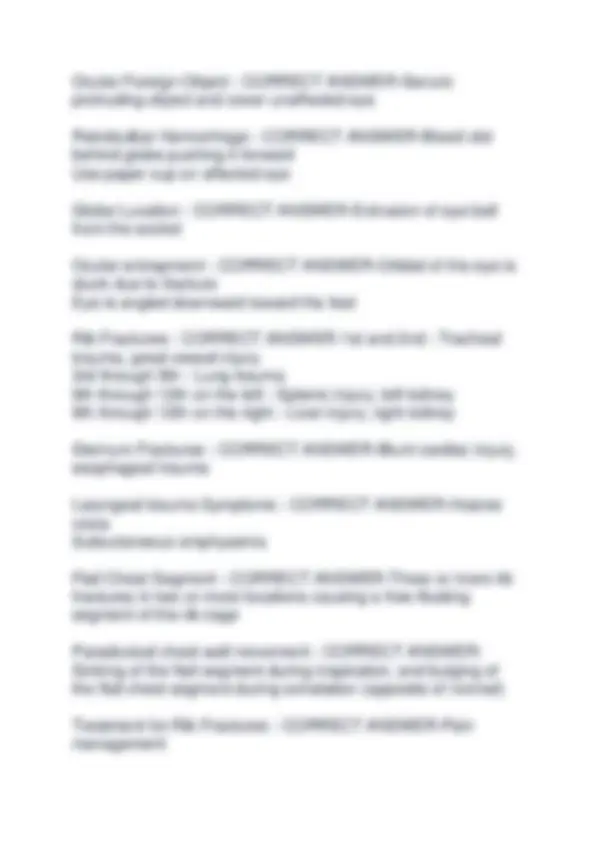
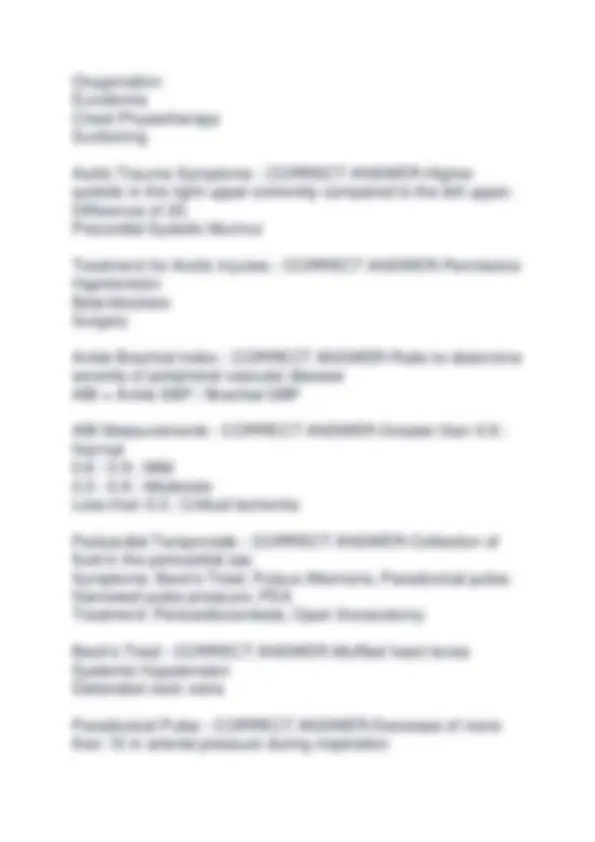
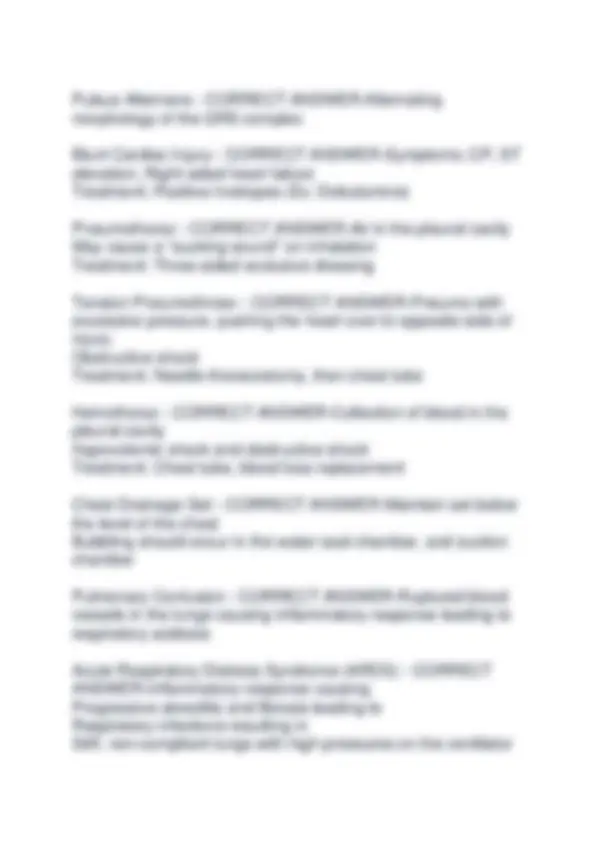
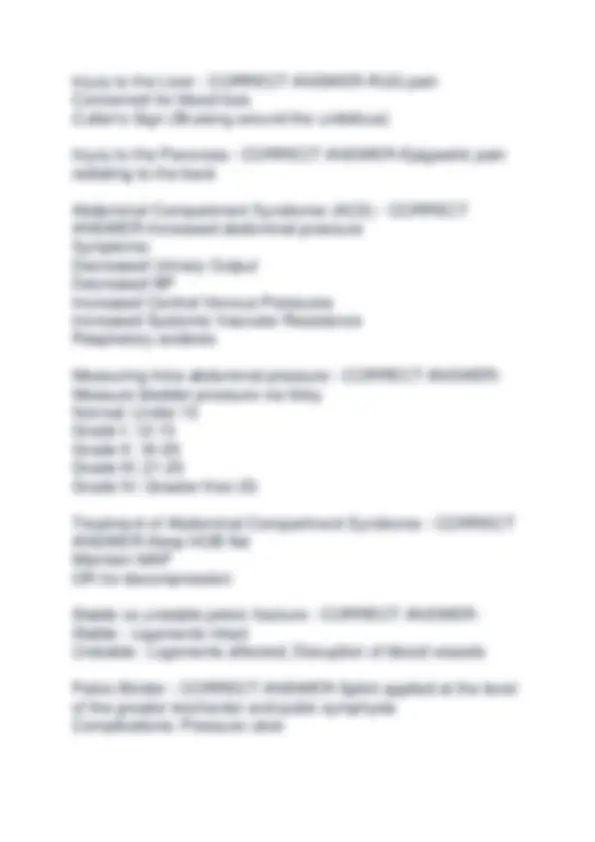
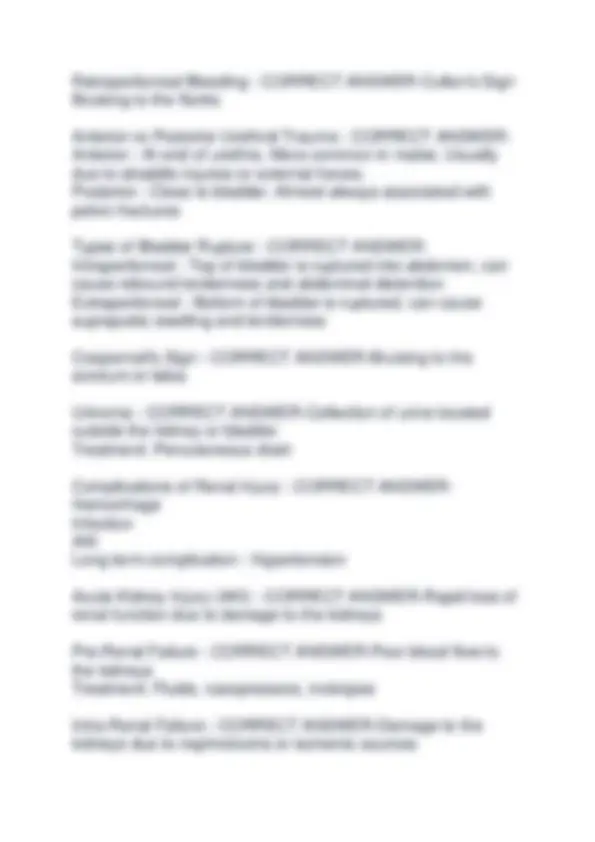
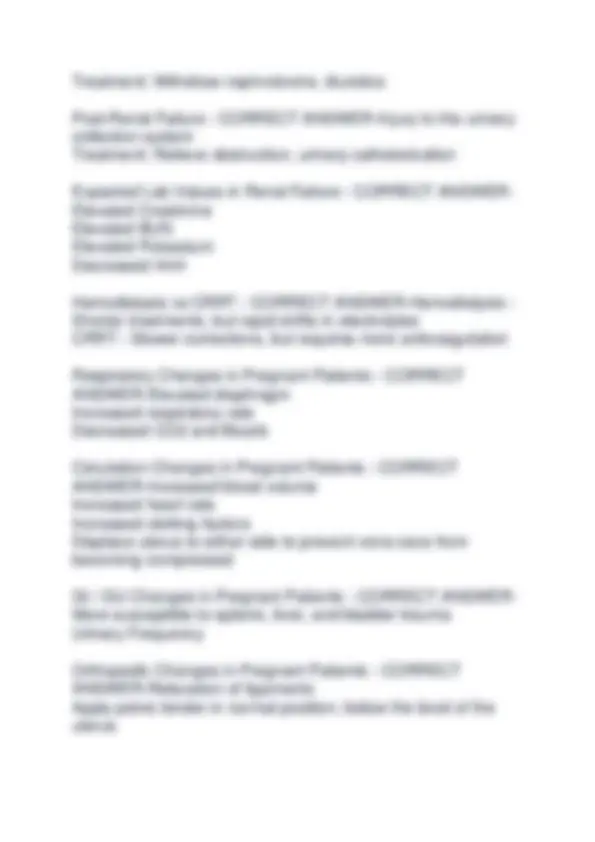
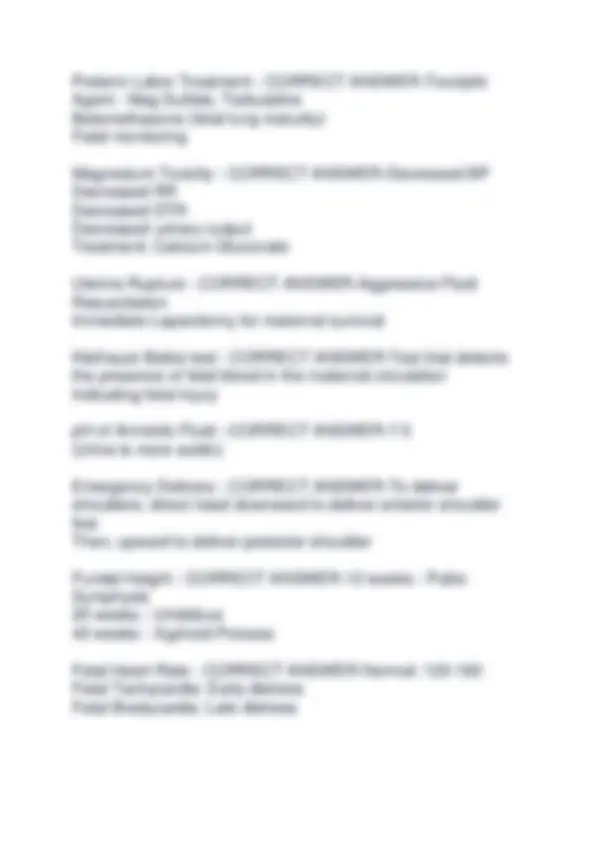
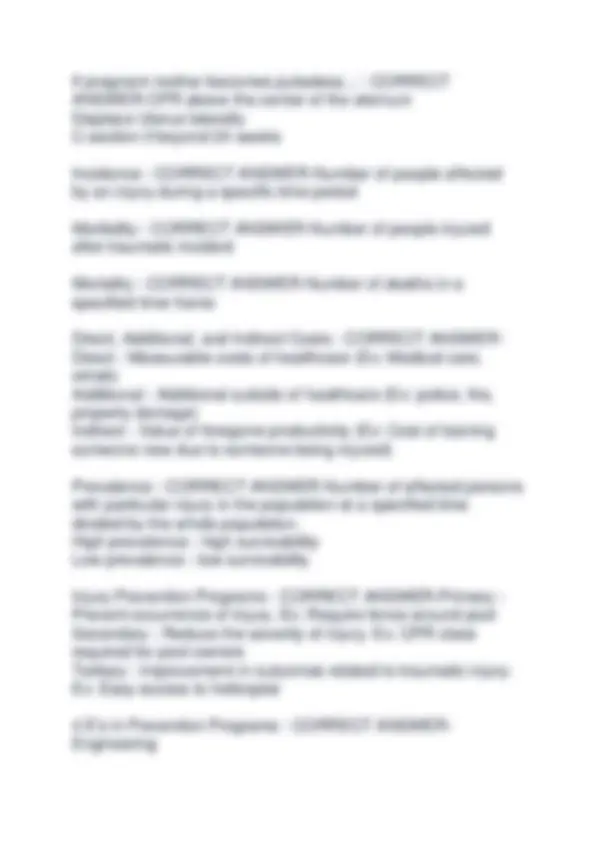
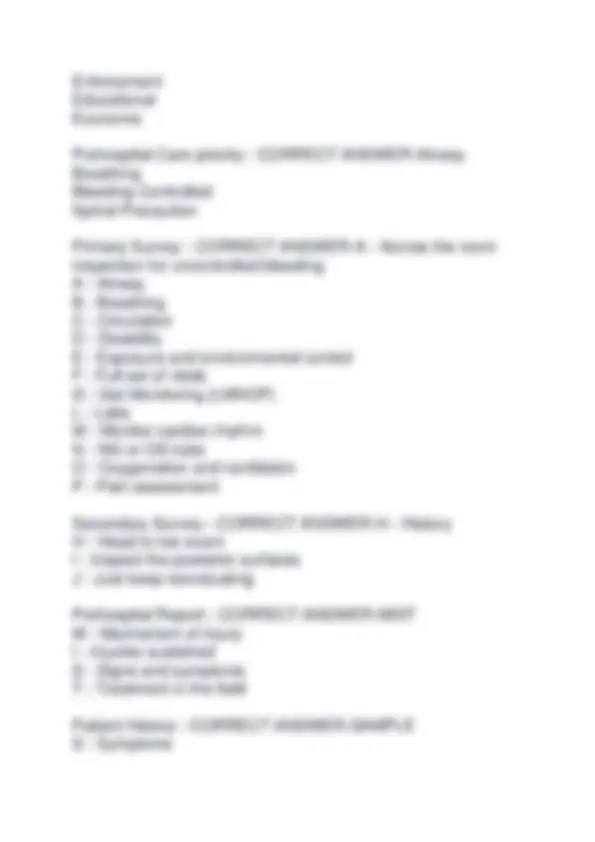
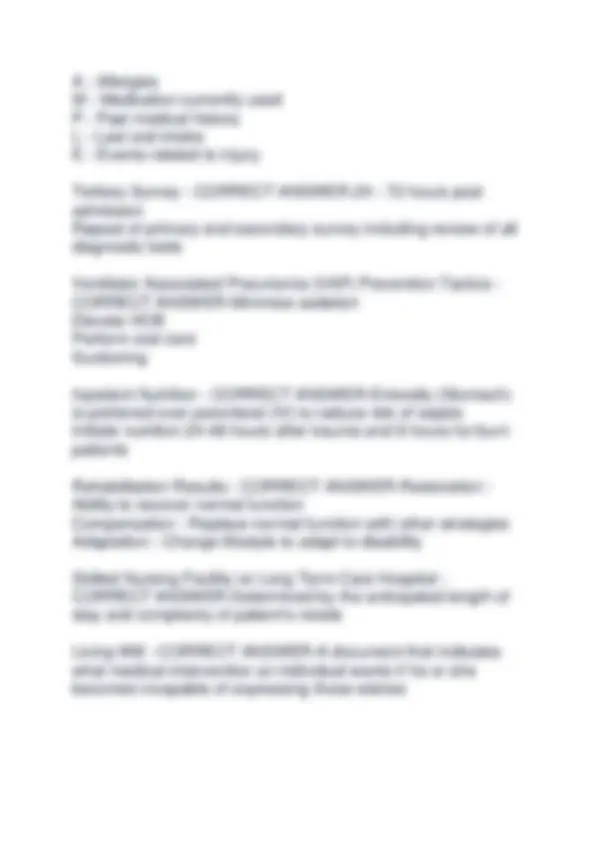
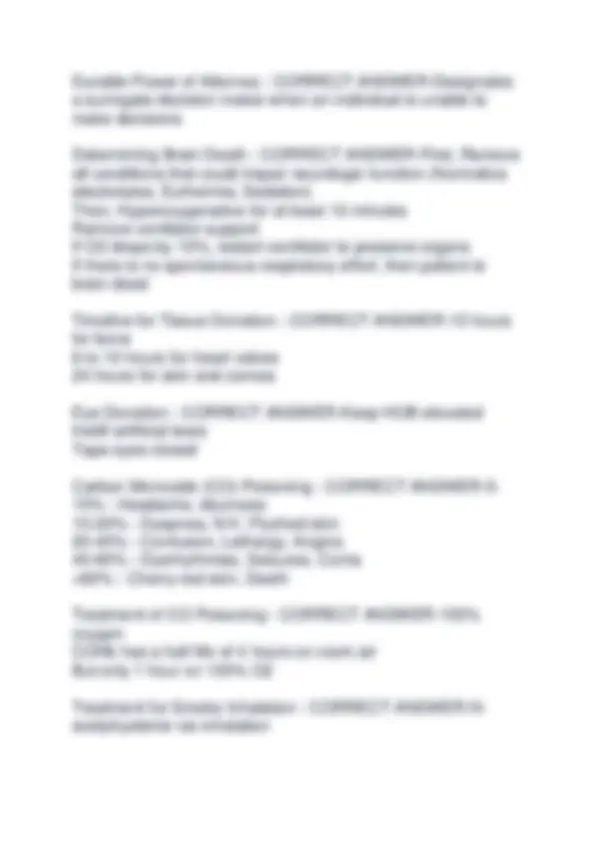
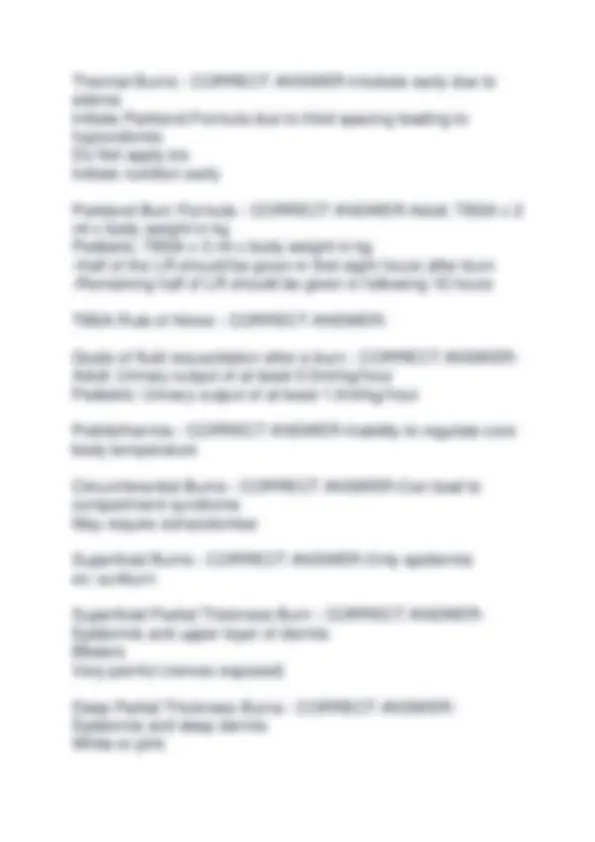
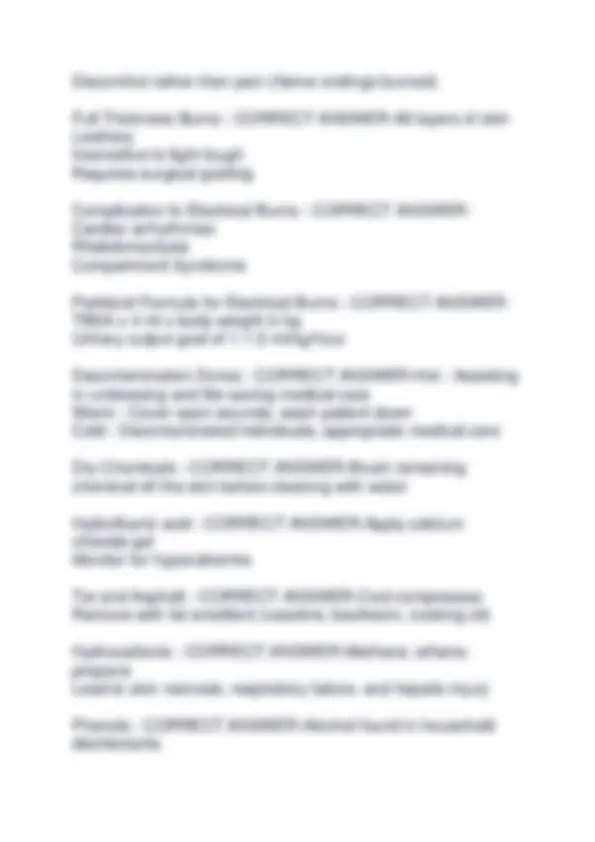
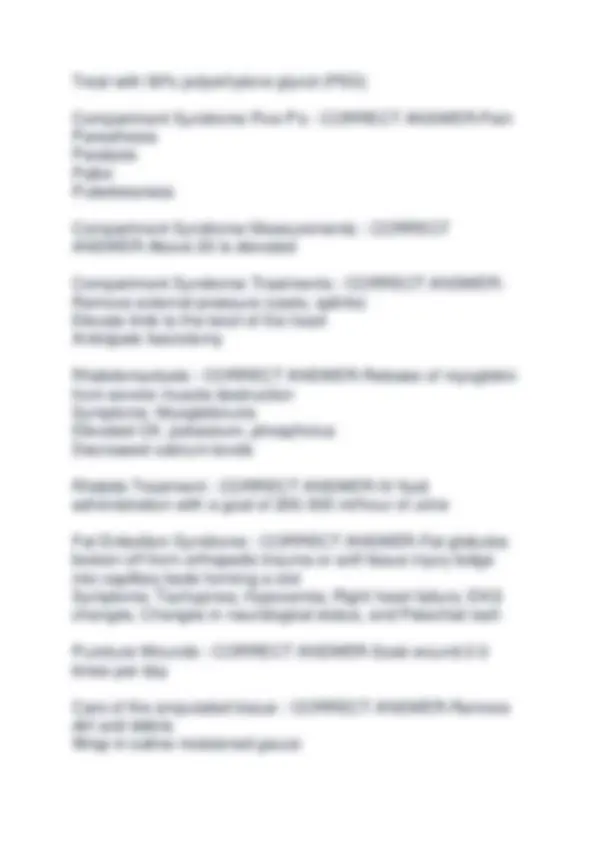
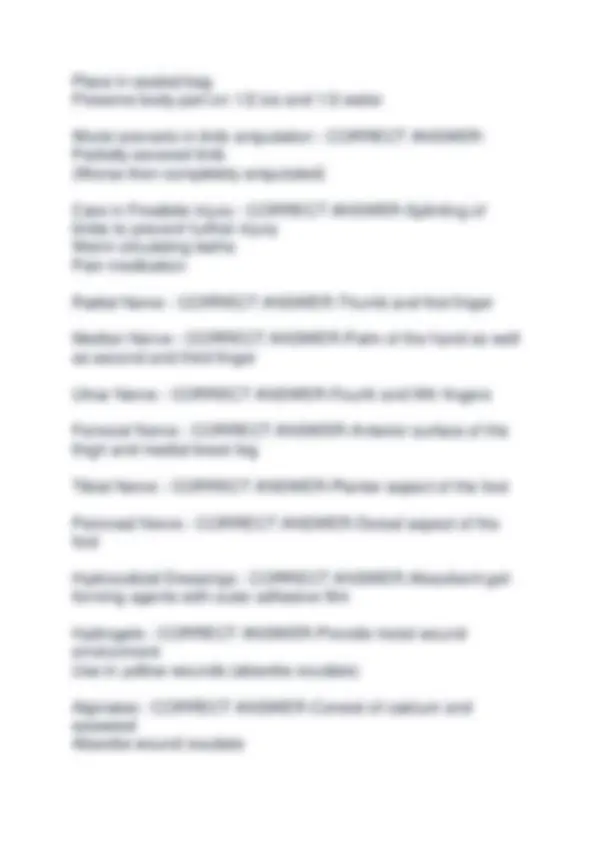
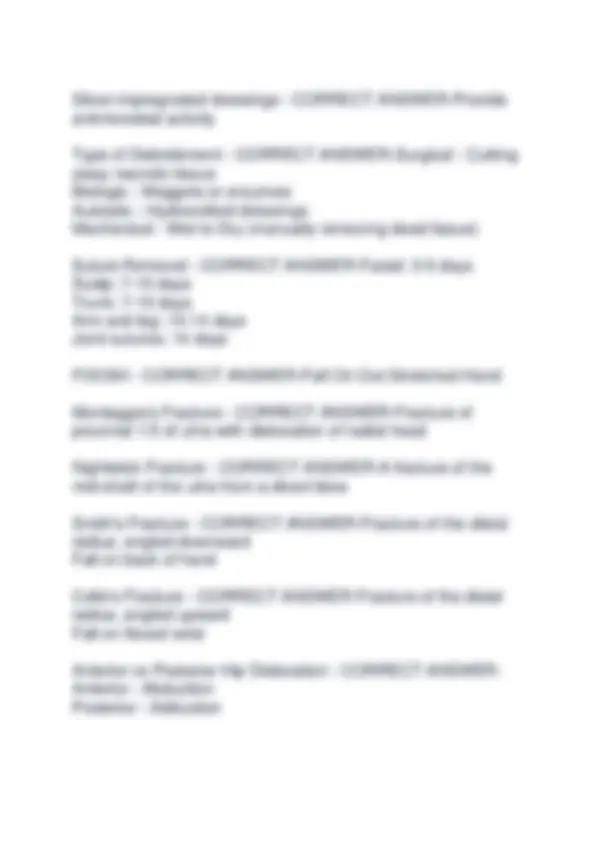
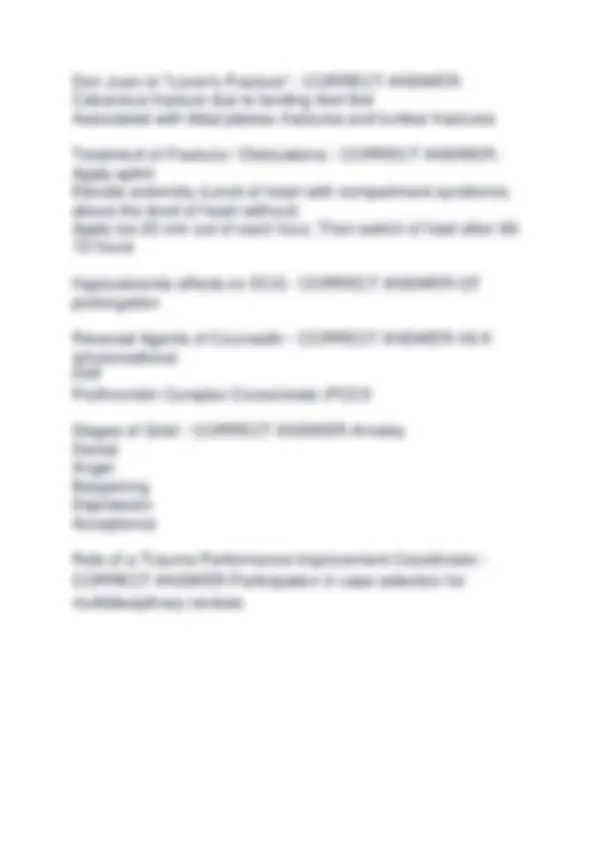


Study with the several resources on Docsity

Earn points by helping other students or get them with a premium plan


Prepare for your exams
Study with the several resources on Docsity

Earn points to download
Earn points by helping other students or get them with a premium plan
Community
Ask the community for help and clear up your study doubts
Discover the best universities in your country according to Docsity users
Free resources
Download our free guides on studying techniques, anxiety management strategies, and thesis advice from Docsity tutors
A comprehensive review of key concepts related to shock, trauma, and neurological conditions, including definitions, causes, symptoms, treatments, and relevant medical protocols. It includes a series of questions and answers that can be used for self-assessment or exam preparation. Topics such as hypovolemic shock, distributive shock, cardiogenic shock, obstructive shock, systemic inflammatory response syndrome (sirs), trauma triad of death, coagulopathies, blood transfusion protocols, intracranial pressure management, and neurological assessment.
Typology: Exams
1 / 31

This page cannot be seen from the preview
Don't miss anything!
























Shock - CORRECT ANSWER-Lack of oxygen to the cells Hypovolemic Shock - CORRECT ANSWER-Lack of volume ex: hemorrhage, burns Distributive Shock - CORRECT ANSWER-Maldistribution of blood (pooled in extremities) Decreased preload ex: neurogenic shock Cardiogenic Shock - CORRECT ANSWER-Inadequate cardiac output ex: blunt cardiac trauma Obstructive Shock - CORRECT ANSWER-Inability of blood to enter or exit heart properly ex: tamponade, tension pneumothorax Systemic Inflammatory Response Syndrome (SIRS) - CORRECT ANSWER-Severe tissue trauma activates an inflammatory response leading to vasodilation, capillary permeability, and coagulation Early (Compensated) Shock - CORRECT ANSWER-Normal BP Weak, thready pulse Deep and rapid RR Normal lactic levels Anxious
Late (Decompensated) Shock - CORRECT ANSWER- Decreased BP Tachycardia Shallow and rapid RR Increased Lactic Decreased LOC Decreased urinary output BUN to Creatinine Ratio - CORRECT ANSWER-Normal - 10: Indicated effective renal function Trauma Triad of Death - CORRECT ANSWER-Hypothermia Acidosis Coagulopathies Effects of Acidosis - CORRECT ANSWER-Increased ICP Exacerbates coagulopathies Depressed myocardial contractility DIC - CORRECT ANSWER-Excessive clotting > all clotting factors used > no more clotting > excessive bleeding Effects of coagulopathies - CORRECT ANSWER-Decreased platelet count Decreased fibrinogen Decreased HnH Increased PT, PTT Increased Ddimer Multi-Organ Dysfunction Syndrome (MODS) - CORRECT ANSWER-Irreversible Shock resulting from Triad of Death Symptoms start within the first week after trauma Steps to control hemorrhage - CORRECT ANSWER- Tourniquet TXA REBOA
MTP Protocol - CORRECT ANSWER-1 : 1 : 1 RBC : Plasma : Platelet Blood Loss Grades - CORRECT ANSWER-I - Loss of 15% with normal BP II - Loss of 15-30% with normal BP III - Loss: of 31-40% with lowered BP IV - Loss > 40% with hemodynamic instability Permissive Hypotension - CORRECT ANSWER-Maintaining BP as low as 70/40 so allow for clotting. Contra-indicated in head injuries, peds, and elderly SCIWORA - CORRECT ANSWER-Spinal Cord Injury WithOut Radiological Abnormality Common in Age < 2 yrs Significance of Bariatric Patients - CORRECT ANSWER- Increased HR and RR at baseline Increased abdominal pressures Increased risk of coagulopathies SBIRT - CORRECT ANSWER-Comprehensive intervention to deliver treatment for substance use disorders Screening Brief Intervention Referral to Treatment Triad of Abusive Brain Injury - CORRECT ANSWER-Subdural Hemorrhage Retinal Hemorrhage Decreased LOC Types of Stress Disorders - CORRECT ANSWER-State of Crisis - Immediately after event Acute Stress Disorder - Lasting at least three days
Post Traumatic Stress Disorder - Lasting one month or longer Three things to identify state of crisis - CORRECT ANSWER-1. Perception of the event
Compassion Fatigue - CORRECT ANSWER-Loss of nurse's ability to empathize and provide compassionate care to patients Secondary Traumatic Stress leading to Burnout Autonomy - CORRECT ANSWER-Ability of individual to determine his/her own course of action ex: not receiving blood due to religious reasons Beneficence - CORRECT ANSWER-Duty of health care providers to be a benefit to the patients ex: prevent or remove harm from the patient Non-maleficence - CORRECT ANSWER-Do no harm ex: honor DNR status of patient Veracity - CORRECT ANSWER-Honesty, providing all information needed to make balanced decision ex: review all risks and benefits of surgery prior to consent Justice - CORRECT ANSWER-Fair distribution of goods in society ex: medicare/medicaid Protected Health Information may be shared to: - CORRECT ANSWER-Past, present or future providers Law enforcement Medical reviews Intracranial Pressure Measurements - CORRECT ANSWER- 0 - 15 Normal 20 - 40 Elevated Above 40 Severely Elevated Deficits in Elevated ICP (20-40) - CORRECT ANSWER- Ipsilateral - deficits above the neck on same side of bleed Contralateral - deficits below the neck on opposite side of blood Vomiting
Disorientation Restlessness Deficits in Severely Elevated ICP (Above 40) - CORRECT ANSWER-LOC Posturing Cushing's Triad Decorticate vs Decerebrate - CORRECT ANSWER- DeCORticate - Hands are pulled towards the CORE (Early) DEcErEbratE - Extension of the arms and legs (Late) Extraventricular Device (EVD) - CORRECT ANSWER-Allows drainage of CSF fluid Keep HOB 30 degrees Keep transducer level with the Foramen of Monro (Ear canal) Excessive drainage could lead to subdural hematoma Basilar Skull Fractures - CORRECT ANSWER-Anterior Fossa fracture - Around eyes and forehead (Could affect eyes and nose) Middle Fossa - Around ears (Could affect hearing) Posterior Fossa - Posterior portion of the head (Could lose gag reflex, or movement of the neck or tongue) Cerebral Contusion - CORRECT ANSWER-Bruising on the surface of the brain Three Meninges - CORRECT ANSWER-Pia Arachnoid Dura Meninges PAD the brain Epidural Bleed - CORRECT ANSWER-Between the skull and dura mater Arterial
Tests for CSF leakage - CORRECT ANSWER-"Halo" test Reagent strip - test for glucose Cerebral Perfusion Pressure (CPP) - CORRECT ANSWER- CPP = MAP - ICP Indirect measurement of cerebral oxygen delivery CPP Measurements - CORRECT ANSWER- 80 - 100: Healthy Above is 60: Required for consciousness Less than 50: Critical reduction in brain tissue oxygenation Less than 30: Irreversible brain ischemia MAP - CORRECT ANSWER-Mean Arterial Pressure MAP = (2D + S) / 3 Treatment of Elevated ICP - CORRECT ANSWER-Reducing volume of the brain (mannitol, hypertonic saline) Reducing the volume of the blood (elevated HOB, reduce cerebral activity, Anti-seizure medication) Reducing the volume of CSF (EVD) Maximize oxygenation (Reduction in CO2 in critical situations) Normalize blood glucose level Normalize temperature Spinal Cord Inuries - CORRECT ANSWER-C1-C4 - breathe no more C5-T1 - upper extremities T4 - Nipple line T7 and above - lose the ability to cough T10 - Hip line L2-L5 - lower extremities S3 - That's the end Anterior Cord Injury - CORRECT ANSWER-Descending (Brain to Body) Loss of motor function
Posterior Cord Injury - CORRECT ANSWER-Ascending (Body to Brain) Loss of proprioception, vibration, fine touch Lateral Cord - CORRECT ANSWER-Ascending (Body to Brain) Controls pain, temperature, crude touch Central Cord Injury - CORRECT ANSWER-Greater loss of motor function in upper vs lower extremities More likely to affect lateral cord Brown-Sequard Injury - CORRECT ANSWER-Loss of motor function on same side of injury Loss of pain and temp on opposite side of injury Cauda-Equina Syndrome - CORRECT ANSWER-Damage to lower spinal cord, resulting in problems with bowel and bladder control Spinal Shock - CORRECT ANSWER-Temporary neurological deficits immediately after spinal injury Islands of Sparing - CORRECT ANSWER-Areas without deficits due to a partial cord injury Sensory Assessment in SCI - CORRECT ANSWER-Start from areas of decreased sensation and move towards areas of increased sensation Neurogenic Shock - CORRECT ANSWER-Activation of parasympathetic nervous system causing vasodilation, hypotension and bradycardia Treat with fluids, and vasopressors Autonomic Dysreflexia symptoms - CORRECT ANSWER- Hypertension Bradycardia
Ocular Foreign Object - CORRECT ANSWER-Secure protruding object and cover unaffected eye Retrobulbar Hemorrhage - CORRECT ANSWER-Blood clot behind globe pushing it forward Use paper cup on affected eye Globe Luxation - CORRECT ANSWER-Extrusion of eye ball from the socket Ocular entrapment - CORRECT ANSWER-Orbital of the eye is stuck due to fracture Eye is angled downward toward the feet Rib Fractures - CORRECT ANSWER-1st and 2nd - Tracheal trauma, great vessel injury 3rd through 9th - Lung trauma 9th through 12th on the left - Splenic injury, left kidney 9th through 12th on the right - Liver injury, right kidney Sternum Fractures - CORRECT ANSWER-Blunt cardiac injury, esophageal trauma Laryngeal trauma Symptoms - CORRECT ANSWER-Hoarse voice Subcutaneous emphysema Flail Chest Segment - CORRECT ANSWER-Three or more rib fractures in two or more locations causing a free-floating segment of the rib cage Paradoxical chest wall movement - CORRECT ANSWER- Sinking of the flail segment during inspiration, and bulging of the flail chest segment during exhalation (opposite of normal) Treatment for Rib Fractures - CORRECT ANSWER-Pain management
Oxygenation Euvolemia Chest Physiotherapy Suctioning Aortic Trauma Symptoms - CORRECT ANSWER-Higher systolic in the right upper extremity compared to the left upper. Difference of 20. Precordial Systolic Murmur Treatment for Aortic Injuries - CORRECT ANSWER-Permissive Hypotension Beta-blockers Surgery Ankle Brachial Index - CORRECT ANSWER-Ratio to determine severity of peripheral vascular disease ABI = Ankle SBP / Brachial SBP ABI Measurements - CORRECT ANSWER-Greater than 0.9 : Normal 0.6 - 0.9 : Mild 0.3 - 0.6 : Moderate Less than 0.3 : Critical Ischemia Pericardial Tamponade - CORRECT ANSWER-Collection of fluid in the pericardial sac Symptoms: Beck's Triad, Pulsus Alternans, Paradoxical pulse, Narrowed pulse pressure, PEA Treatment: Pericardiocentesis, Open thoracotomy Beck's Triad - CORRECT ANSWER-Muffled heart tones Systemic Hypotension Distended neck veins Paradoxical Pulse - CORRECT ANSWER-Decrease of more than 10 in arterial pressure during inspiration
P:F ratio - CORRECT ANSWER-Indirect measurement of the degree of oxygenation across the alveolar membrane P:F ratio = Oxygen in the blood (PaO2) / Oxygen delivered (FiO2) Healthy Adult = 400 Mild ARDS = 200- 300 Moderate ARDS = 100- 200 Severe ARDS = Less then 100 Treatment of ARDS - CORRECT ANSWER-Euvolemia Lower Tidal Volume Elevated PEEP Prone Positioning ECMO Extracorporeal Membrane Oxygenation (ECMO) - CORRECT ANSWER-System that circulates the blood through an oxygenation system, to allow for the heart and lungs to recover Ruptured Diaphragm - CORRECT ANSWER-Symptoms: Heart sounds shift to the right side Pain to LEFT shoulder Signs of obstructive shock Dysphagia Dyspnea Confirmed by laparotomy Treatment: Surgery Seatbelt Sign - CORRECT ANSWER-Bruising along the lower abdomen Concern for small bowl injury and fractures of the lumbar spine Steps for Abdominal Assessment - CORRECT ANSWER- Visualization Auscultation Percussion
Palpation Tympany vs Dullness - CORRECT ANSWER-Tympany - Hyperresonance, Air, Hollow organs Dullness - Hyporesonance, Fluid, Solid organs Narrowed vs Widened Pulse Pressure - CORRECT ANSWER- Narrowed - Concerned for bleeding Widened - Concerned for head injuries Rebound Tenderness - CORRECT ANSWER-Pain that increases when pressure is removed due to irritation caused by presence of blood, enzymes, and bacterial contaminants Hollow Organs - CORRECT ANSWER-Esophagus, Stomach, Small intestine, Large intestine Complications of Hollow Organ Injuries - CORRECT ANSWER- Hematomas can cause obstructions hours or days after trauma Expected elevated WBC count, amylase, and lactic acid levels Escaping air can cause tympany and abdominal distention Rebound Tenderness Solid Organs - CORRECT ANSWER-Spleen, Liver, Pancreas, Kidneys Injury to the Spleen - CORRECT ANSWER-LUQ pain, Left shoulder pain Concerned for major blood loss Vulnerable to infections Treatment: Splenorrhaphy (surgical repair) or Splenectomy Long-term complications from a Splenectomy - CORRECT ANSWER-Vulnerable to infections caused by encapsulated bacteria: Flu, PNA, Meningococcus, E.coli, Staph, and Strep
Retroperitoneal Bleeding - CORRECT ANSWER-Cullen's Sign Bruising to the flanks Anterior vs Posterior Urethral Trauma - CORRECT ANSWER- Anterior - At end of urethra. More common in males. Usually due to straddle injuries or external forces. Posterior - Close to bladder. Almost always associated with pelvic fractures Types of Bladder Rupture - CORRECT ANSWER- Intraperitoneal - Top of bladder is ruptured into abdomen, can cause rebound tenderness and abdominal distention Extraperitoneal - Bottom of bladder is ruptured, can cause suprapubic swelling and tenderness Coopernail's Sign - CORRECT ANSWER-Bruising to the scrotum or labia Urinoma - CORRECT ANSWER-Collection of urine located outside the kidney or bladder Treatment: Percutaneous drain Complications of Renal Injury - CORRECT ANSWER- Hemorrhage Infection AKI Long term complication - Hypertension Acute Kidney Injury (AKI) - CORRECT ANSWER-Rapid loss of renal function due to damage to the kidneys Pre-Renal Failure - CORRECT ANSWER-Poor blood flow to the kidneys Treatment: Fluids, vasopressors, inotropes Intra-Renal Failure - CORRECT ANSWER-Damage to the kidneys due to nephrotoxins or ischemic sources
Treatment: Withdraw nephrotoxins, diuretics Post-Renal Failure - CORRECT ANSWER-Injury to the urinary collection system Treatment: Relieve obstruction, urinary catheterization Expected Lab Values in Renal Failure - CORRECT ANSWER- Elevated Creatinine Elevated BUN Elevated Potassium Decreased HnH Hemodialysis vs CRRT - CORRECT ANSWER-Hemodialysis - Shorter treatments, but rapid shifts in electrolytes CRRT - Slower corrections, but requires more anticoagulation Respiratory Changes in Pregnant Patients - CORRECT ANSWER-Elevated diaphragm Increased respiratory rate Decreased CO2 and Bicarb Circulation Changes in Pregnant Patients - CORRECT ANSWER-Increased blood volume Increased heart rate Increased clotting factors Displace uterus to either side to prevent vena cava from becoming compressed GI / GU Changes in Pregnant Patients - CORRECT ANSWER- More susceptible to splenic, liver, and bladder trauma Urinary Frequency Orthopedic Changes in Pregnant Patients - CORRECT ANSWER-Relaxation of ligaments Apply pelvic binder in normal position, below the level of the uterus